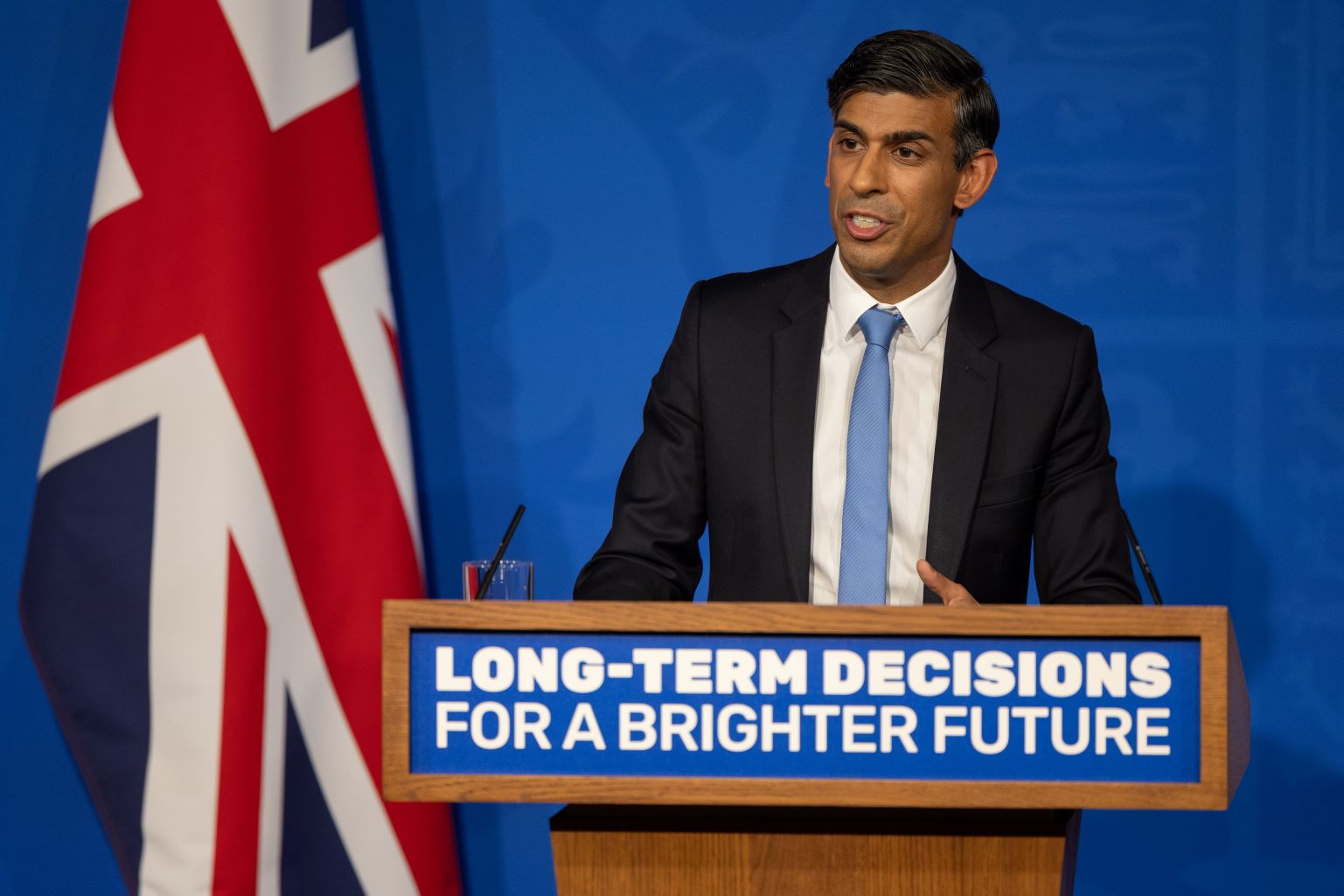Growth will be a key focus of the forthcoming Autumn Statement, which the Chancellor of the Exchequer will deliver this Wednesday. Anna Valero, Esin Serin and Brendan Curran argue that effective measures to promote greener growth will be essential to ensuring that the UK does not fall behind other countries when it comes to incentivising investment that is good for society and the environment as well as the economy.
This year’s Autumn Statement comes at a time of significant fiscal constraints, yet it represents a critical moment for the Chancellor to set out policies for growth – addressing the fact that the UK has become a “stagnation nation” in need of a new economic strategy. Zero growth was experienced in the third quarter of 2023, and the Bank of England has forecasted zero growth in 2024. Underlying the current context and outlook is 15 years of weak productivity performance: restoring productivity growth requires lasting policies and an overall strategy to increase business investment in capital, innovation and skills.
Policies that improve the general incentives for long-term investment would help to stimulate much-needed investments for net zero. But this is a moment where we might reasonably hope for new announcements on net zero specifically – including on the UK’s response to President Biden’s Inflation Reduction Act (IRA). New commitments focused on delivering net zero would help to restore the UK’s credibility on the world stage ahead of COP28 following the recent watering down of commitments regarding decarbonising cars and homes, and the phasing down of oil and gas. How could Chancellor Jeremy Hunt build on the measures he has announced in recent days to deliver on the UK’s pursuit of sustainable growth?
New commitments focused on delivering net zero would help to restore the UK’s credibility on the world stage ahead of COP28 following the recent watering down of commitments
Improving the investment ecosystem
Evidence suggests that a range of general features of the UK’s business investment ecosystem can be improved, and a set of reforms – implemented together – could increase the UK’s investment rate (which has lagged behind its main comparators for some time). A priority for the Autumn Statement should be to make permanent the (currently temporary) full expensing of business plant and machinery for tax purposes, as this would have the effect of increasing the capital stock as opposed to merely bringing investment forwards. A more ambitious approach would extend full expensing to other types of capital investment, paying for this by limiting the tax deductibility of interest (which would also have the benefit of reducing the bias towards debt finance).
As Hunt emphasised in his Mansion House speech, pensions offer a plausible route to increased investment in UK productive assets – as well as more engaged ownership of the UK’s larger firms which might discipline management to focus on investment for long-term value creation. There is a strong case for creating a new UK Growth Fund, managed by the British Business Bank or UK Infrastructure Bank and overseen by HM Treasury, to attract long-term capital from major institutional investors into key growth sectors. Given fiscal pressures, it is appropriate that the Government looks to leverage private sector co-investment to meet the long-term goal of sustainable growth.
These reforms, as well as others – in particular reforms to address the UK’s significant planning barriers – would not only stimulate investment in general, but would be likely to benefit net zero investments too, which are particularly capital intensive. The National Infrastructure Commission has estimated that in order to deliver net zero, the UK will need additional private sector investment of £20 to £35 billion per year from 2025 to 2050 in technologies such as renewables, electricity networks, hydrogen and carbon capture and storage.
Incentivising low carbon investment
Given the range of market failures, path dependencies and coordination challenges associated with net zero investments, additional, more targeted policies are needed. These would not only encourage the investment needed for the UK to meet its own challenging targets, but also maximise the nation’s chances of accessing growth opportunities during the transition. In particular, as the net zero transition picks up pace globally, the UK can leverage its technological strengths in key areas like carbon capture usage and storage (CCUS), offshore wind and tidal stream energy, as well as in relevant services (eg, green finance) as part of a broader growth strategy.
As the net zero transition picks up pace globally, the UK can leverage its technological strengths in key areas like carbon capture usage and storage (CCUS), offshore wind and tidal stream energy
But with many other advanced economies looking to build capabilities and market share in these same areas – in particular the US with the IRA and the EU with its Green New Deal – the UK has a narrowing window to attract investment to expand supply chains domestically and maintain its competitive edge. For example, countries around the world are working to bring new CCUS facilities online, with the US – which opened its first commercial direct air capture plant in recent weeks – seeing especially significant momentum since the IRA. Meanwhile, the final investment decisions for UK’s first set of CCUS projects are not expected to be reached for almost another year.
Recent announcements are encouraging. Changes to the Contracts for Differences (CfDs) – the UK’s flagship mechanism to support low-carbon energy projects – include an increase to the maximum strike prices to improve the economic viability of projects, as well as a proposal to introduce “Sustainable Industry Rewards” to the auction process from 2025. Such rewards will offer enhanced revenue support to projects if they reduce emissions from their supply chains, or if they improve social benefits (eg, through investment in local communities and skills). This could be the beginning of an IRA-style conditionality approach in UK policy to ensure investments underpinned by public sector support deliver not only economic but also wider environmental and social benefits. For example, the IRA contains enhanced tax incentives for projects in disadvantaged areas and those that commit to “good” wages and apprenticeships.
Maximising the benefits of the CfD will also require continued efforts to remove other barriers facing low-carbon investments, including those related to planning and the grid, for which the new Ofgem policy to clear “zombie projects” from connection queues is an important step. Actions to encourage local communities to accept green infrastructure are also welcome, and a new scheme to compensate communities for new pylons via reduced bills has also been announced (though it is important to ensure that compensation and support during the transition more generally is targeted towards those that need it most).
A broader suite of “green industrial policies”, including enhanced support (eg, via grants or specific tax incentives) for clean-tech investment and innovation is needed to help leverage the UK’s strengths and expand productive capacity. In this respect, the £960 million earmarked for green industries within a broader £4.5 billion package for advanced manufacturing are important steps. The CBI has proposed a targeted “green super-deduction” to encourage green capital investments. Given the need for green skills to deliver investments in net zero and change across the economy, one idea is to trial human capital tax credits that would incentivise firms to invest in accredited green skills for their workers.
Disincentivising high carbon activities
We have argued previously that it is difficult to see an economic justification for the Government supporting new drilling for oil and gas in the North Sea. But the Autumn Statement is an opportunity to correct broader incentives that favour high-carbon investment and activities in the economy. For example, the provision of capital allowances under the windfall tax for oil and gas but not under the equivalent scheme for low-carbon electricity creates a perverse investment signal that needs to be corrected in support of the UK’s net zero transition.
The Autumn Statement is an opportunity to correct broader incentives that favour high-carbon investment and activities in the economy.
Road transport is another area where reforms are needed to disincentivise high-carbon activity and protect public finances over time. Fuel duty provides an implicit disincentive to fossil fuels in motoring but has been frozen since 2011. Its ability to raise revenue will erode further as the UK continues to transition to electric vehicles (EVs), leaving the Government with the task of finding a viable, long-term replacement to fill the looming fiscal hole. Indeed, the Climate Change Committee estimated that the switch to EVs would put around £35 billion of current annual Government tax receipts at risk, the majority coming from fuel duty. Road pricing could offer the much-needed replacement to fuel duty, internalising carbon emissions alongside a range of other negative externalities (including air pollution and congestion) within the cost of driving.
Short-term politics vs long-term economics
With an election looming, political pressures shaping fiscal policy and broader Government announcements are particularly intense. But given the tight and uncertain fiscal outlook, the need for reforms that can boost the UK’s long-term growth potential in a sustainable way is as urgent as ever. Policy stability on key areas that determine business investment – in general and towards net zero – will help, and the establishment of a new independent growth and productivity institution (eg, a National Growth Board) would facilitate long-term decision-making in light of short-term political pressures. More detailed proposals on what this institution might look like will be launched during National Productivity Week. And a major Economy 2030 Inquiry conference on 4 December will set out a new economic strategy for the UK, describing a path to a fairer and more prosperous future.
This commentary has been co-published with the Grantham Research Institute on Climate Change and the Environment
All articles posted on this blog give the views of the author(s), and not the position of LSE British Politics and Policy, nor of the London School of Economics and Political Science.
Image credit: HM Treasury on Flickr







